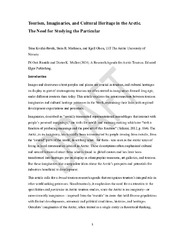Tourism, imaginaries, and cultural heritage in the Arctic: The need for studying the particular
Abstract
Imaginaries, described as “socially transmitted representational assemblages that interact with people’s personal imaginings,” are tools for world- and meaning making which are “both a function of producing meanings and the product of this function” (Salazar, 2012, p. 864). The Arctic, as an imaginary, has typically been a constructed by people coming from outside, from the “central” parts of the world, describing what - for them - was seen as the exotic ways of living in local communities labeled as Arctic. These descriptions often emphasized cultural and natural features distinct from what is found in global centers and has later been transformed into heritages put on display in ethnographic museums, art galleries, and tourism. But these imaginaries also encapsulate ideas about the Arctic’s prospects and potentials for industries beneficial to development.
This article calls for a broad tourism research agenda that recognizes tourism’s integral role in other worldmaking processes. Simultaneously, it emphasizes the need for an attention to the specificities and particular in Arctic tourism studies, since the Arctic is an imaginary - or more correctly imaginaries - imposed from the ‘outside’ on areas that hold diverse populations with distinct developments, economic and political conditions, histories, and heritages. Outsiders’ imaginaries of the Arctic, when treated as a single entity in theoretical thinking, may oversimplify the complex colonialities in various parts of what from the outside is seen as the Arctic, but are home to those residing there.
The article begins with an exploration of early outsiders’ descriptions of the Arctic, before we discuss them as imaginaries of Otherness. We use the concept of Arctification to describe how an imaginary of the Arctic has become localized in places previously regarded as Northern Europe. Using the northern part of Fennoscandia as our focal point, the article underscores the importance of caution and awareness when researchers frame their analysis within the imaginary of the Arctic, as researchers themselves still contribute to perpetuating these ‘socially transmitted representational assemblages,’ as conceptualized by Noel Salazar (2012).


 English
English norsk
norsk